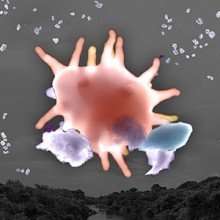Fungal spores are a primary source of sodium salt particles in Amazon air

Tiny particles of sodium salt float in the air over the pristine Amazon basin. Why? The only explanation before now has been that winds blow marine particles hundreds of miles inland from the Atlantic Ocean. An international team of scientists used chemical imaging and atmospheric models to prove otherwise. They discovered that, during the wet season, fungal spores make up as much as 69 percent of the airborne sodium salt particles in the central Amazon basin.
Particles in the air act as nuclei to form ice and clouds. Never have fungal spores been considered a significant source of these particles over the Amazon. By understanding where and when sodium salt particles will be present and in what quantities, scientists can better predict cloud formation and the effect of changes in the terrestrial ecosystem on long-term climate patterns.
Scientists from EMSL partnered with colleagues at Pacific Northwest National Laboratory, Lawrence Berkeley National Laboratory (LBNL), University of California at Berkeley, Purdue University, China's Xiamen University, Germany's Max Planck Institute for Chemistry, and Brazil's Federal University of São Paulo, University of São Paulo, and Federal University of Para on a project to determine the source of sodium salt particles in the Amazon. The team collected samples of airborne particles during the beginning of the wet season from a pristine rainforest site in the Amazon region.
They then applied a variety of chemical imaging techniques such as EMSL's scanning electron microscope and secondary ion mass spectrometry, and LBNL's scanning transmission X-ray microscope in the Advanced Light Source to analyze particle size and composition. Results showed that locally emitted fungal spores contributed considerably to sodium salt particles, which were previously solely attributed to oceanic emissions. To evaluate the geographic distribution and frequency of high fungal spores over the Amazon basin, they conducted simulations using the Community Earth System Model. Modeling results suggested that fungal spores account for approximately 69 percent of the total sodium mass during the wet season and that their fractional contribution increases during the night. The work offers new insights into the composition of Amazon air and suggests areas for further study.
More information: Swarup China et al. Fungal spores as a source of sodium salt particles in the Amazon basin, Nature Communications (2018). DOI: 10.1038/s41467-018-07066-4
Journal information: Nature Communications
Provided by Environmental Molecular Sciences Laboratory


















